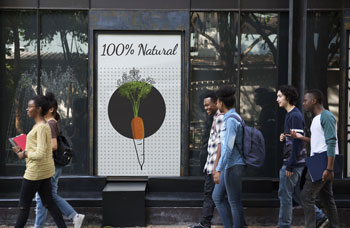Stay in the know to adapt and grow
While 2018 saw minimum wage increases, automated reservations and cashless restaurants as the major trends, the restaurant industry is experiencing big changes this year in customer behavior, real estate and the upgraded dining experience.
Although 2019 will be a good year for the restaurant industry, casualties will continue. These will not be attributed to a slow economy (as in recent years), but to those not paying attention to the current changes in society and individuals’ lifestyles, which are being mirrored in food service.
Restaurant operators must be equipped to better connect with customers and must be more agile in order to prosper in a fast-changing society. We have compiled research and narrowed down 5 large trends that are influencing this shift in the restaurant and foodservice industries.
Focus:
- Delivery
- Real Estate
- Conscious eating and spending
- Dining Experiences
- Brand Risk
1. Third-party delivery and take out will reign supreme

Delivery revenue is expected to pick up and restaurants will see this revenue in several ways. Research from a delivery and catering study by CHD Expert shows restaurant industry projections.
In 2019:
- Pick-up orders are projected to make $124 billion in sales
- Direct restaurant delivery will reach $32 billion
- Delivery from third-party services will reach $13 billion.
As customer preferences continue to shift and change, there is a widening divide between customers who are looking for a memorable restaurant experience and those who are just looking for convenience.
As delivery becomes a larger piece of the puzzle, restaurant owners will need to adjust back of house operating models to accommodate higher volumes during peak delivery hours, as well as find new ways to streamline the pickup process for front of house operations. This means finding other ways to handle pickup and third-party orders other than having individuals got to the bar area.
Some smaller establishments have built an entire pick-up section, with its own pickup window, POS system and an employee to man the operation. Larger establishments have chosen to build more autonomous pick up and take-out operations, such as DIY kiosks.
A completely new concept has emerged from this delivery trend as well. Ghost restaurants are now becoming a thing due do the overwhelming volume of third-party delivery. These are virtual eateries that operate via delivery only, by taking orders online and delivering the food to the customer directly. These operation models are easier to scale because they don’t require large overhead costs. Forbes explains that these may replace home kitchens, so don’t shut your doors to customers just yet.
2. Real Estate costs are likely to improve

According to RSM US financial advisory firm, landlords are beginning to feel the pain caused by restaurant bankruptcies and rent costs are starting to decline, which is great news. However, many restaurants are continuing to modify their operating models in order to adapt to more affordable, smaller spaces and are experimenting with concepts that cater more specifically to the take-out and delivery customer base.
Smaller kitchen equipment is a part of this trend. Restaurant equipment manufacturers have created small yet heavy-duty equipment, such as the Moffat half-size convection oven, the Nemco counter top electric range, and the warming and baking oven to fill this need. Brands that specialize in catering equipment have also started to make ultra-lightweight food carriers to help businesses cater to the rising demand of food delivery.
3. Conscious eating for customers means conscious spending for you

Consumers are more into health and wellness than ever before and things like clean eating and veganism are long past the fad phase – they are now an ongoing trend. According to food and beverage advisory firm RSM, while millennials mostly care about whether the food they’re consuming is healthy and will benefit their physical appearance, Generation Z consumers want to know more.
They not only want to know if a product is plant based, but how it is made and by whom. Although this is geared toward grocery stores and product stocking, it is also important for restaurant operators to source ingredients wisely. Customers are quick to move on if they don’t feel like they are making a healthy and sustainable meal choice.
Restaurant Business magazine has noted that customers will now expect more transparency on business performance and everything it holds, such as diversity, fair trade, living wages, environmental conservation and a stance on animal welfare. It might sound overwhelming but think of the 2018 banishment of plastic straws and reduction of plastic utensils as an indicator of what customers who are “conscious-minded” want to see in 2019.
Zero-waste kitchens is the new hit this year, with more owners streamlining their entire operations to reduce their environmental footprint. Ordering from local vendors, composting and using just-in-time ordering are but a few ways that operators are maintaining lean inventories, and thus, less waste.
Any moves to diminish waste, be more transparent and publicize your impact on the environment will attract these conscious customers who are willing to spend their hard-earned money in a like-minded establishment.
4. Customers crave unique dining experiences

Food quality and service has been at the heart of the restaurant industry since it began, and this will continue well into the future.
As competition grows with non-traditional foodservice establishments providing pre-made, ready-to-order meals for busy customers, restaurants will need to find new ways to offer patrons more memorable fine and casual dining experiences.
This year, the industry will lean toward creating unique experiences for guests. This means getting more creative than your typical restaurant week or offering two-for-one meals and happy hour specials. For instance, the restaurant reservation site Resy recently launched a new program called “Off Menu Week,” where restaurants in major cities nationwide are offering special off-menu dishes.
Customers can taste new creations for a very limited time at some of the best restaurants and feel like they are getting “insider” treatment from their favorite places. Customers want to feel like they are forming a connection with the creative minds behind some of their favorite dining establishments.
This would be a great opportunity for restaurants to serve that one dish that never made it to the menu, or experiment with a new one and cultivate a “behind-the-scenes experience,” perhaps even giving patrons the authority to vote on whether it should stay on the menu. Creating unique dining experiences in 2019 will keep patrons dining in your establishment instead of opting for an alternative option all together.
5. Brand reputation is tops
Food safety has always been at the forefront of the restaurant business, but now cybersecurity is sharing this space as a top risk factor for business. With competition steadily growing in the industry, restaurant brands will continue to take the blame when a food-borne illness or credit card fraud is linked to one of their locations, having a negative impact on their reputation.
Food safety issues are costing the restaurant industry billions each year and customers are paying more attention to the food they eat. Advances in restaurant technology will help keep cyber threats at bay and identify contamination in food supply to mitigate these incidents. Businesses can now use technology such as RFID tags that sense potential food contamination, thanks to MIT. Many POS systems such as Lavu have data monitoring built into the platform.

Hackers will continue to be a nuisance for foodservice businesses moving forward as their talent for data mining can reach well beyond password-protected systems. Businesses will need to build protocols for customer database monitoring and a good communications plan in case a breach occurs, or a food safety issue arises.
Restaurants that prove to be successful are ones that can adapt to industry trends and use them to their benefit, by making them their own. While it is difficult for any restaurant to adopt all trends, it’s best to find at least one or two that you can easily translate to fit your operation and brand. Small ideas can lead to greater, more positive outcomes and the most important thing is to stay true to your brand.
Did you enjoy this article?
Subscribe to stay up to date on industry news and receive exclusive sales and promotions.


